Sorted by date Results 1 - 23 of 23
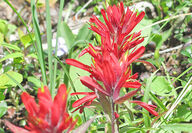
Years ago, I was hiking over a high mountain pass enjoying the insane, kamikaze flights of at least fifty hummingbirds intent on gathering nectar from a field of brilliant red paintbrushes. I was euphoric, completely surrounded by their buzzing antics, when a wild-eyed, bearded, gnome-like man burst out of the nearby forest bellowing expletives at me. I stopped on the trail, more confused by the man running towards me than worried. I felt like I had hiked into a fairy tale. Ends up he was a...

Ferns evolved 360 million years ago when the supercontinent Pangaea still existed. They are one of earth's most ancient plants and predated dinosaurs, mammals and flowering plants by over 120 million years. Once plant-eating dinosaurs evolved, ferns were their main meal. Luckily for the dinosaurs, ancient ferns were bigger than bite-sized; many species grew over 100 feet tall! Ferns are vascular, which means they have internal vessels through which they pump water and nutrients. Vascular plants...
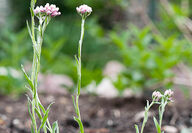
Rosy Pussytoes (Antennaria rosea) are one of my favorite wildflowers. You might ask why, since they're pretty small in every aspect. I love them because they are tough little buggers and can grow in extreme habitats. I can't tell you how many times I have been hiking in rocky, mountainous terrain and been delighted by their sweet, pink nodding flowers. They also grow throughout our valley in the forest and grasslands. Rosy pussytoes are in the Composite Family (Asteraceae). Flowers in this...
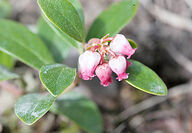
Kinnickinnick, or bearberry, which grows throughout the forests of the West, often goes unnoticed because it is not a showy plant. But it is one of my favorites because each spring, when the arrival of warm weather seems utterly improbable, kinnickinnick's bright red berries and tiny evergreen leaves are the first to emerge from under the snow. Its resilience always reassures me the earth will come back to life. Originally, kinnickinnick was a trading term eastern tribes gave to all plants that...
I am writing to encourage you to vote for Cecil Schlabach for HD 92. My husband, Juan, and I had the pleasure of getting to know Cecil this spring and we were impressed by his integrity, kindness, and far-reaching capabilities. Every cell in his body is infused with a clear and honest intent to create a better world and we can’t imagine a finer candidate. What I appreciate when talking with Cecil is that he has no hidden agendas, no ulterior motives. He is sincerely a man who cares about Montana’s incredible countryside, its economic vit...
Fires alter wildlife’s food, water and shelter forcing animals to either adjust or find new homes. In an intense fire, the complex humus layer on the forest floor gets charred, depleting nutrients and causing soils to repel water. Erosion is greater and the compromised soil produces less nutritious food for the animals. Despite the hit it has taken, nature starts healing. In the spring, broad-leaved plants such as Rocky Mountain maple, dogwood, willow and aspen sprout from their roots and flowers like fireweed get established. Their leaves begi...
Wildlife has evolved with fires over the eons. Though wildfire certainly takes its toll, not as many animals die as one might expect. However, more animals die if fires occur early in the season when babies are still being cared for or if fires are severe, as so many are today. Raptors, like eagles and hawks, have keen eyesight and acute hearing, so are forewarned of fire before most other species. They easily escape the flames and also take advantage of the opportunity to prey on animals such as rodents, small mammals, and insects fleeing from...
Smoke. More smoke. Ridiculous amounts of smoke. That has been what we in Seeley Lake have been breathing and looking through since July 24th. We know the smoke is impacting our health but how is it impacting the trees and plants? Plants breathe and photosynthesize through openings called stomata. When wildfire smoke fills the air, plants reduce the size of their stomata, which means that just like us, they can’t breath as well, and their ability to photosynthesize is reduced. So yes, they’re stressed. And yes, they want the smoke to go just as...
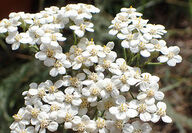
Yarrow, Achillea millefolium, is one of my favorite flowers because it is tough and the deer don't seem to like it. Its shallow roots make transplanting easy and it tolerates some neglect in the process. It is drought resistant and spreads by shallow rhizomes, so it fills my flower garden even when I forget to water it! Yarrow is in the Composite Family, not the Parsley Family as some might guess, so please learn to identify it correctly before using it. To the untrained eye, some poisonous...
As the Rice Ridge fire pressed down upon us and I prepared to evacuate, my belongings felt like a burden. Protecting them was clearly not worth the loss of someone’s life. I couldn’t help but wish that our culture lived on the land differently. When tribal people inhabited the West they co-existed with fires. Their homes were lightweight and portable so tribes could easily move their few possessions if needed. No one’s life was put at risk fighting fires. Because fires cycled through frequently they improved habitats rather than devas...
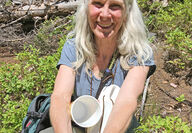
The huckleberries are on! These wild, sweet berries define living in the Rockies for many. I love eating huckleberries but I love picking them more. Moving slowly from bush to bush I experience the woods much more intimately than when I'm hiking. Life's chatter drops away and I feel renewed. The Japanese call this "forest bathing." There are twelve species of huckleberries (Vaccinium spp.) in the Rocky Mountains. Members of the Heath Family, they grow from 3,500 feet up to about 7,000 feet...
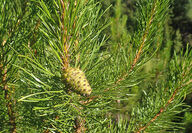
by Randi de Santa Anna When the bark beetles were in full swing I copped an attitude against lodgepole pines. They seemed weak and a waste of space in the forest. But I have come to understand their important role in fire ecology habitats and have adjusted my attitude. Though short-lived, lodgepole pines, Pinus contorta, are the most common Rocky Mountain tree species north of New Mexico because they are fast growing, reproduce prolifically and can inhabit almost any soil. Lodgepoles produce...
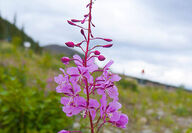
If you have ever hiked into a year-old burn, you most likely know what fireweed looks like. The appearance of its tall, pink flowers covering the recently blackened slopes is as reliable as the appearance of morel mushrooms. Fireweed, Chamerion augustifolium, is in the Evening Primrose Family. Its skinny seedpods produce thousands of fluffy seeds, but its most effective means of spreading is through its persistent underground rhizomes. The good news is that if fireweed gets established in your v...
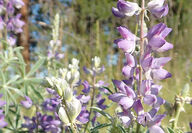
The robust flower spikes that paint our forest floor purple are lupines. Though lupine seedpods look a lot like domestic peas and specific species were cultivated for thousands of years in the Andes and the Mediterranean, most species are poisonous and should not be eaten. The alkaloids in lupines have killed many sheep, horses, cows and goats. Lupine (Lupinus) belongs to the Legume Family and we have ten species in Montana. In our rural environment where deer abound, lupines can be a rewarding...
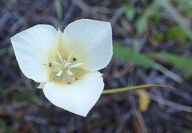
I am so appreciative of the many successions of flower blooms here in Montana! After the remarkable beargrass show we just had down in the valley, the mariposa lilies have come on in full force. Mariposa means "butterfly" in Spanish. If you take a walk right now you'll see the tiny bright "butterflies" of individual mariposas scattered throughout the forest. In my mind they are the epitome of delicate – three creamy white petals blooming at the tip of a grey green stalk bearing one long, s...
When I first moved West in the 1970s I fell in love with aspen trees. They symbolized wildness and spontaneity, new adventures and breaking away from entrenched paths. My youthful anthropomorphizing aside, it’s hard not to like an aspen grove with its fluttering leaves and tall white trunks. Apparently, many species feel the same. Almost 200 species are supported by aspen groves! Quaking aspen (Populus tremuloides) is the widest ranging tree in America. It is in the Willow Family along with cottonwoods, poplars and of course, willows. Entire gr...
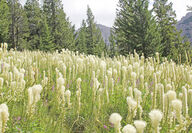
It's a good beargrass year. The slopes on either side of Highway 83 are filled with their tall, crazy looking flowers. It's worth taking a drive or hiking up a trail to witness how beautifully their white blooms decorate our forest-covered mountains. Beargrass (Xerophyllum tenax) is in the Lily Family. Each stalk has hundreds of flower buds, which start blooming from the bottom of the stalk and bloom upwards to the top. Blooming patches of beargrass light the forest up as if they were torches....
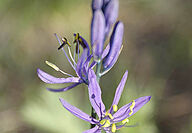
As you drive along Highway 200 through Potomac you can see several purple-tinged fields off to the north. The purple color is camas flowers. Camas, Camassia quamash, is in the Lily Family. The root of purple camas was a main food source for Native people on the western side of the Rockies up into British Columbia. It was a highly prized trading commodity. The bulbs could be eaten raw but were usually roasted in a pit from one to three days, which turned their starches into fructose making the...
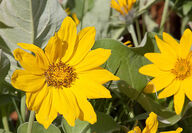
I didn't fully appreciate how incredible our balsamroot bloom was until we took my mother to the Bison Range. Mom was a flower gardener and had lived back East her whole life so we weren't sure how she'd respond to the drier habitat balsamroot prefers. The flowers were at their peak, as they are right now in the Seeley Swan. From the Bison Range vista point Mom looked out at the endless, overlapping hillsides cloaked in yellow blooms, interlaced with the purples, whites and pinks from other...
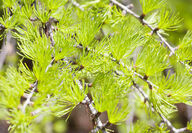
The larches that have looked dead for the past six months have not disappointed us. They have greened up! Oh happy day! Our mountains are once again adorned with that incredible praying mantis green. The fact that larches (Larix occidentalis) drop their needles defines so much of their existence. Unlike most conifers that keep their needles year round enabling them to photosynthesize whenever the temperatures rise above freezing, larches can only grow half of the year. They make up for this...
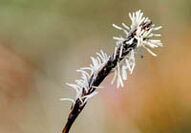
If you take a walk through the woods right now and look close to the ground you'll see tiny, chaotic puffs of creamy yellow at or near the top of what looks like blades of bunchgrass. But they aren't bunchgrass – they are sedge plants. Sedge flowers don't have showy petals so if you move too fast you'll miss them. But go slowly and use a magnifying glass or hand lens and you'll see that those puffs are made up of stamens coated with yellow pollen (the male part of a flower) and clear white p...
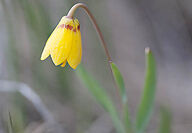
A glorious little flower found early in the spring among the sage and bunchgrass is the yellow fritillary or yellow bell, Fritillaria pudica. It's a member of the Lily Family (Liliaceae) and it blooms in the grasslands and ponderosa pine country. You can tell it's in the Lily Family because the veins on its leaves all run parallel and its flower parts are in threes - three petals and three sepals. But the sepals, which in most plant families are green, leafy structures that protect the flower in...
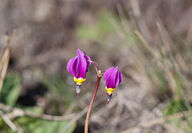
Springbeauty started blooming in the grasslands of the Seeley Swan Valley in early April and its bloom will gradually work its way up in elevation. It is in the Purslane Family (Portulacaceae). One of the coolest things about this tiny plant is its ability to move through its life cycle quickly and successfully. In the fall, when the growing season is done, Springbeauty starts growing from its tiny bulb. Its sprout continues to grow during the winter to just below the soil surface. By doing...